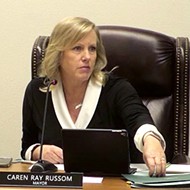[{
"name": "Ad - Medium Rectangle CC01 - 300x250",
"id": "AdMediumRectangleCC01300x250",
"class": "inlineCenter",
"insertPoint": "8",
"component": "2963441",
"requiredCountToDisplay": "12"
},{
"name": "Ad - Medium Rectangle LC01 - 300x250",
"id": "AdMediumRectangleCC01300x250",
"class": "inlineCenter",
"insertPoint": "18",
"component": "2963441",
"requiredCountToDisplay": "22"
},{
"name": "Ad - Medium Rectangle LC09 - 300x250",
"id": "AdMediumRectangleLC09300x250",
"class": "inlineCenter",
"insertPoint": "28",
"component": "3252660",
"requiredCountToDisplay": "32"
}]
After almost five years on the books, Excelaron’s oil drilling proposal is in the hands of San Luis Obispo County planning commissioners. And if the first public hearing was any indicator, there’s still a long road ahead.
The Planning Commission met on Feb. 23 to discuss Excelaron’s request for a conditional use permit to construct four test wells in rural Huasna Valley. Following a staff presentation and more than three hours of public comment, commissioners decided to continue the hearing to their next scheduled meeting, set for March 8.
Planning staffers have recommended denial of the permit, citing the potential environmental impacts, land-use inconsistencies, fire safety, and neighborhood compatibility.
If approved, Excelaron’s project would come in four phases. Phase one of the project could be capable of producing up to 500 barrels of oil per day.
At the hearing, planners outlined issues identified by the Environmental Impact Report, including five class one impacts (those that can’t be mitigated) ranging from noise violations to concerns for the local red-legged frog.
But Excelaron brought its own experts who said that much of the information that had been presented by the planning staff was inaccurate.
Acoustics expert Dr. David Dubbink, for example, gave a detailed and lengthy account of the difference between decibel measurement systems, citing what he felt were very specific inaccuracies in the way noise was measured in the EIR.
After hearing five minutes of deeply technical information, Chair Commissioner Dan O’Grady asked Dubbink to kindly summarize his presentation.
Grant Jagelman, managing director of the Australian Oil Company and the former Excelaron lead, said the company had invested more than $4 million and six years in the project, what he called “an exhaustive, independent, professional response to all the issues and concerns that have been raised about this project.”
Public comments ranged from support for the project on the basis of job creation, tax revenue, and the creation of the Solar for Schools Project, to rejection of the project on the basis of sight, smell, and principle. Based on the comments received, public opinion of the project is mixed, leaning slightly against Excelaron’s plans. Some people praised the project’s potential to create jobs and bring in taxes, while others asked county officials to reject Excelaron’s proposal because of the unwanted impacts.
Business owner and newest member of the Solar for Schools board of directors Aaron Steed said he supported Excelaron because of the “positive environmental impact [Solar for Schools] could have on our community.”
If the project moves forward, Excelaron promised to donate $1 to Solar for Schools for every oil barrel produced, up to $1,000 a day, for as long as Excelaron remains in operation. The nonprofit would fund green technology efforts in local schools.
On the other side of the argument, Tom Davis, speaking on behalf of burger joint In-N-Out, said he and his employer wanted the valley to remain the way it is. He described the 4,834 acres of land In-N-Out owns there as a “serene place, it’s a place of beauty; it’s a place of quiet.”
He said the valley is home to “hassles of wild boars, and gangs of wild turkeys, and deer and hawks and several other species of birds.”
Latest in News
Readers also liked…
-

Coast Unified teachers upset over new position's salary and qualifications
Oct 20, 2022 -

SLO police identify alleged driver who hit and killed couple
Dec 22, 2022 -

When the levee breaks: Oceano residents, county officials walk a tightrope of regulations to manage Arroyo Grande Creek, which some say led to the levee's failure in January
May 18, 2023








